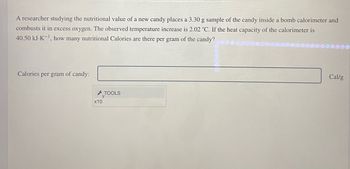
Chemistry
10th Edition
ISBN: 9781305957404
Author: Steven S. Zumdahl, Susan A. Zumdahl, Donald J. DeCoste
Publisher: Cengage Learning
expand_more
expand_more
format_list_bulleted
Question

Transcribed Image Text:A researcher studying the nutritional value of a new candy places a 3.30 g sample of the candy inside a bomb calorimeter and
combusts it in excess oxygen. The observed temperature increase is 2.02 °C. If the heat capacity of the calorimeter is
40.50 kJ-K-¹, how many nutritional Calories are there per gram of the candy?
Calories per gram of candy:
r
x10
TOOLS
Cal/g
Expert Solution
This question has been solved!
Explore an expertly crafted, step-by-step solution for a thorough understanding of key concepts.
This is a popular solution
Trending nowThis is a popular solution!
Step by stepSolved in 2 steps

Knowledge Booster
Learn more about
Need a deep-dive on the concept behind this application? Look no further. Learn more about this topic, chemistry and related others by exploring similar questions and additional content below.Similar questions
- A 22.1g piece of aluminum (which has a molar capacity of 24.03 J/oC.mol) is heated to 82.4oC and dropped into a calorimeter containing water (specific heat capacity of water is 4.18J/goC) initially at 22.3oC. The final temperature of the water is 25.8oC. Ignoring significant figures, calculate the mass of the water in the calorimeter.arrow_forwardA 6.78 g sample of methanol was combusted in a bomb calorimeter. The temperature of the calorimeter increased by 12.7 °C. If the molar mass of methanol is 32.04 g/mol, and the heat capacity of the calorimeter is 5,104 J/°C, what is the molar AE for this reaction, in kJ/mol? Do not report units in your answer. Report your answer to one decimal place and include the correct sign.arrow_forwardWhen 1.836 grams of sucrose (Molar mass 342.3 g/mol) is burned in a bomb calorimeter, the temperature of the calorimeter increases from 22.41°C to 26.63°C. If the heat capacity of the calorimeter is 4.900 kJ/°C, what is the heat of combustion of sucrose?arrow_forward
- When 9.1 g of a hydrocarbon is combusted in a bomb calorimeter the temperature of the calorimeter increases from 23.8 C to 53.5 C. The calorimeter contains 731 g of water and the heat capacity of the bomb is 872 J/ C. Please calculate q rxn, in kJ, for the combustion of the hydrocarbon.arrow_forwardA particular container holds 3.77 mol of neon gas. The volume of this container can be altered by sliding a piston in or out. The volume is changed from 8.60 L to 12.20 L while at the same time the temperature is changed from 303 K to 345 K. The molar heat capacity, Cym, for neon is 12.47 J/(mol · K). Assume that this value will not change over the given temperature range. What is the change in entropy for the gas? AS = J/K TOOLS x10 MacBook Proarrow_forwarda chemist wastes a delicious brownie by burning it in a bomb calorimeter. before burning, the brownie weighed 16.13 grams. During the combustion process in the bomb calorimeter, the heat of the calorimeter increased by 7.40 degrees celsius. The known heat capacity of the calorimeter that was used was 26.53 kJ/Celsius. What is the energy content, in kJ/g, of this brownie?arrow_forward
- A 56.1 g sample of polystyrene, which has a specific heat capacity of 1.880 J-g °C-1 is put into a calorimeter (see sketch at right) that contains 250.0 g of water. The temperature of the water starts off at 24.0 °C. When the temperature of the water stops changing it's 29.8 °C. The pressure remains constant at 1 atm. Calculate the initial temperature of the polystyrene sample. Be sure your answer is rounded to the correct number of significant digits. °C thermometer. insulated container water sample. a calorimeter 區 OU Ararrow_forwardA bomb calorimeter has a heat capacity of 6.067 kJ/°C. A sample of vitamin (C31H4602) has an internal energy (DE) = -2.278 X 104 kJ/mol. When 1.434 g of the vitamin sample are burned in oxygen in the calorimeter, determine the final temperature in °C if the initial temperature is 14.51 °C.arrow_forward
arrow_back_ios
arrow_forward_ios
Recommended textbooks for you
 ChemistryChemistryISBN:9781305957404Author:Steven S. Zumdahl, Susan A. Zumdahl, Donald J. DeCostePublisher:Cengage Learning
ChemistryChemistryISBN:9781305957404Author:Steven S. Zumdahl, Susan A. Zumdahl, Donald J. DeCostePublisher:Cengage Learning ChemistryChemistryISBN:9781259911156Author:Raymond Chang Dr., Jason Overby ProfessorPublisher:McGraw-Hill Education
ChemistryChemistryISBN:9781259911156Author:Raymond Chang Dr., Jason Overby ProfessorPublisher:McGraw-Hill Education Principles of Instrumental AnalysisChemistryISBN:9781305577213Author:Douglas A. Skoog, F. James Holler, Stanley R. CrouchPublisher:Cengage Learning
Principles of Instrumental AnalysisChemistryISBN:9781305577213Author:Douglas A. Skoog, F. James Holler, Stanley R. CrouchPublisher:Cengage Learning Organic ChemistryChemistryISBN:9780078021558Author:Janice Gorzynski Smith Dr.Publisher:McGraw-Hill Education
Organic ChemistryChemistryISBN:9780078021558Author:Janice Gorzynski Smith Dr.Publisher:McGraw-Hill Education Chemistry: Principles and ReactionsChemistryISBN:9781305079373Author:William L. Masterton, Cecile N. HurleyPublisher:Cengage Learning
Chemistry: Principles and ReactionsChemistryISBN:9781305079373Author:William L. Masterton, Cecile N. HurleyPublisher:Cengage Learning Elementary Principles of Chemical Processes, Bind...ChemistryISBN:9781118431221Author:Richard M. Felder, Ronald W. Rousseau, Lisa G. BullardPublisher:WILEY
Elementary Principles of Chemical Processes, Bind...ChemistryISBN:9781118431221Author:Richard M. Felder, Ronald W. Rousseau, Lisa G. BullardPublisher:WILEY

Chemistry
Chemistry
ISBN:9781305957404
Author:Steven S. Zumdahl, Susan A. Zumdahl, Donald J. DeCoste
Publisher:Cengage Learning

Chemistry
Chemistry
ISBN:9781259911156
Author:Raymond Chang Dr., Jason Overby Professor
Publisher:McGraw-Hill Education

Principles of Instrumental Analysis
Chemistry
ISBN:9781305577213
Author:Douglas A. Skoog, F. James Holler, Stanley R. Crouch
Publisher:Cengage Learning

Organic Chemistry
Chemistry
ISBN:9780078021558
Author:Janice Gorzynski Smith Dr.
Publisher:McGraw-Hill Education

Chemistry: Principles and Reactions
Chemistry
ISBN:9781305079373
Author:William L. Masterton, Cecile N. Hurley
Publisher:Cengage Learning

Elementary Principles of Chemical Processes, Bind...
Chemistry
ISBN:9781118431221
Author:Richard M. Felder, Ronald W. Rousseau, Lisa G. Bullard
Publisher:WILEY